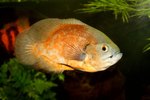
Angelfish are a small family of tropical, reef-dwelling marine life. Although the family is small, these fishes are often among the most conspicuous reef-dwellers due to their vividly colored bodies and interesting, flattened shape. Their bright colors and shape make them favorites in the saltwater aquarium industry; the pet trade is among the largest threat to this family.
Taxonomy
Angelfish belong to the family Pomacanthidae in the order Perciformes. Within the family there are seven genera: Apolemichthys, Centropyge, Chaetodontoplus, Genicanthus, Holacanthus, Pomacanthus and Pygoplites. Within these seven genera are 70- to 80-some species, making this family relatively small when compared to other fish or animals.
Description
In general, angelfish are triangular in shape and have laterally compressed, or flattened, bodies. They closely resemble their relatives, the butterflyfish in the family Chaetodontidae. The only characteristic that distinguishes angelfish from the butterflyfish is a small spine in front of their gill and below the eye. Angelfish are vibrantly colored and have long, continuous dorsal fins. Another characteristic of these colorful fish is a small mouth.
Habitat and Range
These fish prefer habitats along coral reefs, although any shallow, underwater structure will suffice. The coral reefs are the most prominent habitat because they supply the algae which make up the angelfish's diet. They seldom inhabit water deeper than 50 meters; warm waters between 15 to 100 feet deep are most preferable. Most species inhabit waters in the Indo-Pacific region, although the warm waters of the Caribbean are home to a few species.
Hermaphrodites
Like many other reef fish, all species of angelfish are hermaphrodites. These species all begin life as females and switch sex only when required. Within the living structure of most species, one dominant male will be included among a small harem of female fish. If the male is eaten, dies or is otherwise removed from the community, the dominant female of the small community will switch sexes. Sex-switching will also occur if a community becomes too large; one female will switch sex into male and the harem will split into two or more. Other species often are found in pairs.
References
Photo Credits
-
Comstock Images/Comstock/Getty Images
Writer Bio
With a professional background in gardening, landscapes, pests and natural ecosystems, Jasey Kelly has been sharing her knowledge through writing since 2009 and has served as an expert writer in these fields. Kelly's background also includes childcare, and animal rescue and care.



